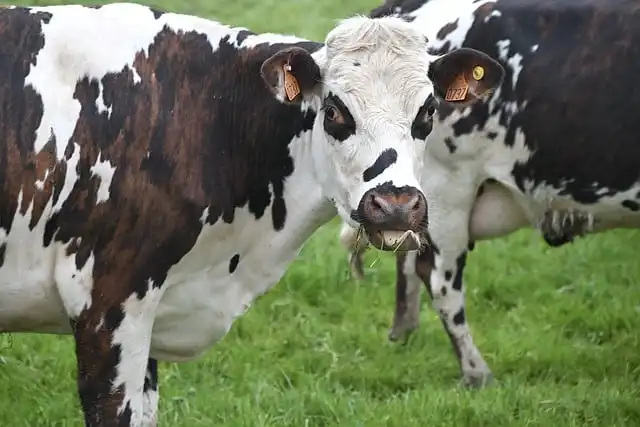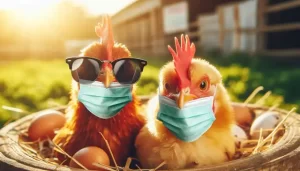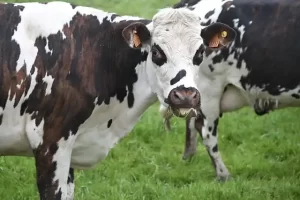Global First: Bovine Avian Influenza Transmission to Humans Detected
- “Miracle Weight-Loss Drug” Sweeps Across America
- The United States Avian Influenza Outbreak Worse Than Expected?
- Global First: Bovine Avian Influenza Transmission to Humans Detected
- Potassium-Enriched Salt Substitutes: Reducing Blood Pressure Risk?
- Tritium Detection in Fukushima’s Seawater: Below Safety Standards
- What Reason Let AstraZeneca Withdraws COVID Vaccine From The Market?
Global First: Bovine Avian Influenza Transmission to Humans Detected
- AstraZeneca Admits for the First Time that its COVID Vaccine Has Blood Clot Side Effects
- Was COVID virus leaked from the Chinese WIV lab?
- HIV Cure Research: New Study Links Viral DNA Levels to Spontaneous Control
- FDA has mandated a top-level black box warning for all marketed CAR-T therapies
- Can people with high blood pressure eat peanuts?
- What is the difference between dopamine and dobutamine?
- How long can the patient live after heart stent surgery?
Global First: Bovine Avian Influenza Transmission to Humans Detected
Global Discovery of the First Case of Bovine Avian Influenza Transmission to Humans: Will There Be Human-to-Human Transmission?
This is the first time that a highly pathogenic H5N1 strain has been found in a cattle herd. According to the US Food and Drug Administration (FDA), traces of the virus were also detected in some unpasteurized milk samples.
Earlier this month, the New England Journal of Medicine (NEJM) published an article by a US team reporting the world’s first suspected case of a cow transmitting highly pathogenic avian influenza virus (H5N1) to humans. The infected individual is a worker on a dairy farm in Texas, USA.
According to the US Department of Agriculture, as of the end of March, the avian influenza virus had been circulating in US cattle herds for about four months, with reports of infection in dozens of herds across the country. Countries such as Canada have strengthened import requirements for US cattle. As of May 6th, approximately 220 farm workers in the US have completed virus screening, and there have been no new reports of human infections with avian influenza.
On May 6th, the World Health Organization (WHO) held a virtual meeting on the outbreak of avian influenza in US cattle. Experts from the US Centers for Disease Control and Prevention (CDC) pointed out that farm workers who do not wear protective gear and have prolonged contact with cattle are at risk of infection, but the public health threat from avian influenza remains low.
Vivien Dugan, head of the flu department at the US CDC, told the media that what needs to be watched out for is that the infection in cattle herds indicates that avian influenza may be circulating in this species. Extensive contact between humans and livestock may make the virus more likely to spread among humans.

Global First: Bovine Avian Influenza Transmission to Humans Detected
How is the first infected person doing?
According to the NEJM article, the aforementioned farm worker developed redness and discomfort in his eyes at the end of March. There was subconjunctival hemorrhage and thin, watery discharge under the right eye. He had no fever or respiratory symptoms, clear lung sounds on auscultation, and oxygen saturation of 97%.
During the same period, reports of cattle infected with avian influenza were reported in several locations in the US, including Texas, where the worker was located. Science points out that this is the first time that a highly pathogenic H5N1 strain has been found in a cattle herd. According to the US FDA, traces of the virus were also detected in some unpasteurized milk samples.
The worker reported no contact with sick or dead poultry or wild birds, but had close contact with diseased dairy cows. He also stated that he wore gloves while working but did not use any respiratory or eye protection.
Based on the results of RT-PCR testing of samples from the right eye and nasopharynx, the worker was diagnosed with infection with highly pathogenic H5N1. He was advised to isolate at home and was treated with the antiviral drug oseltamivir orally. People who had close contact with him also received the relevant drugs for post-exposure prophylaxis.
In the following days, the worker reported feeling well, with significant improvement in conjunctivitis symptoms and no respiratory symptoms. His close contacts were also healthy. Subsequent analysis showed that there was no decrease in sensitivity to the antiviral drug.
As of now, the CDC has not been able to extract samples from the cows or the environment at the worker’s farm for analysis. Additionally, the Texas Department of Agriculture has not agreed to allow the CDC to conduct an epidemiological investigation at the farm in question. Based on this, the NEJM stated that it cannot be ruled out that the worker had contact with other sources of infection or may have been infected by contaminated hands rubbing his eyes or contaminated milk splashing into his eyes.
Coinciding with the publication of the NEJM article, a preprint study from Denmark presented another infection hypothesis. The study showed that the mammary gland tissue of cows contains a rich receptor that is found to easily bind with avian influenza viruses. Such receptors are rare in the cow’s brain and respiratory tract. This explains why in the avian influenza epidemic among US cattle, most infected cows mainly showed signs of mammary gland infection, but there was almost no evidence of respiratory tract infection or neurological symptoms.
At the end of March, a farm worker developed redness and discomfort in his eyes, with subconjunctival hemorrhage and thin, watery discharge under the right eye.
Are Infections in Cattle Unexpected?
“I haven’t been sleeping well lately,” STAT quoted Vivien Dugan as saying, adding that the reasons behind this are complex.
According to data from the US CDC, the country reported its first indigenous case of human infection with H5N1 in April 2022. The patient had previously been in contact with and involved in culling infected poultry. The patient’s infection was mild and he recovered quickly.
Although the patient described in the NEJM article also had mild symptoms, genetic sequencing results showed that he was infected with a specific subtype of H5N1, 2.3.4.4b. All genetic segments were closely related to viruses detected in Texas dairy cows in March 2024, and viruses detected in surrounding wild birds.
The 2.3.4.4b subtype was first detected in 2020 and has since spread globally with wild bird migration. It has become the main avian influenza strain in Asia, Africa, Europe, the Middle East, and elsewhere. In March this year, researchers near the Argentine research station in Antarctica detected the 2.3.4.4b subtype in two dead birds called skuas. A month later, Chile reported a case of human infection with avian influenza, with the culprit being this subtype.
“The infection of cattle herds with 2.3.4.4b is unexpected,” STAT noted, pointing out that this subtype has infected dozens of mammalian species, including large felids, dogs, and foxes, but there have been no reports of cattle infections. As the virus mutates and becomes more adaptable, if it becomes endemic in cattle herds, it could increase the risk of human infection.
Angela Rasmussen, a virologist now working at the University of Saskatchewan in Canada, has expressed similar sentiments. She pointed out that although the farm worker’s symptoms were mild, there is a serious issue behind it: the avian influenza virus may be adapting to mammals, increasing the likelihood of infecting humans through interspecies transmission.
This concern is not unfounded. An article in Nature at the end of April showed that sampling from infected cattle cases in the US, analyzing virus sequences, revealed rich genetic polymorphisms in the virus, with mutations in the protein region. This indicates that the virus has been evolving for several months.
Furthermore, the NEJM article showed that the virus isolated from the worker’s sample had key site mutations (PB2-E627K). In September 2023, a study published in Cell by Chinese researchers suggested that this mutation may enhance the virus’s transmission ability. At that time, China’s chicken population was infected with a new type of H3N8 avian influenza virus, which seemed to exhibit more and more mammalian-adaptive characteristics. In less than a year, China reported three cases of human infection with H3N8. The research
team isolated an H3N8 virus carrying the PB2-E627V mutation from one of the patients. Moreover, even if humans are vaccinated with a targeted vaccine, there seems to be no immune response to this new subtype.
Another source of anxiety for Vivien Dugan comes from epidemiological investigations. On the one hand, the US CDC has encountered difficulties in investigating cases, as many farm workers are unwilling to undergo screening. US media reported that farm workers are economically strained. Without government-provided sick leave, leaving their jobs and cooperating with checks could result in losing their jobs.
On the other hand, there are many gaps in the data. According to the Nature article, the US has collected many samples, but lacks precise collection dates and locations for each sample. As a result, many questions cannot be answered, such as how the virus spreads between cows and cows, and between cattle herds. It is becoming increasingly difficult to control the epidemic of avian influenza in cattle as time goes by.
Will There Be a Pandemic?
Science believes that preventing H5N1 from spreading from cattle farms is a major issue. Most countries, including the United States, require all poultry infected with H5N1 to be culled. However, the cost of culling each cow is as high as $2,500, and since the symptoms after infection are not severe, there has been no discussion about culling cows. The NEJM article suggests that considering the global pandemic potential of the H5N1 virus, vaccine development should be accelerated.
In recent years, avian influenza epidemics have occurred successively in many parts of the world, with occasional cases of human infection.
According to WHO data, the infection rate of H5N1 in humans is not high, but the mortality rate exceeds 50%. From 2003 to April 2024, WHO reported a total of 889 confirmed human cases, including 463 deaths. The strains that cause human infections are mainly H5N1 and H7N9, detected in 2013.
WHO points out that after human infection with H5N1, the disease can range from mild to severe, including asymptomatic infection, mild upper respiratory tract infection (fever and cough), and some may develop into severe pneumonia, acute respiratory distress syndrome, shock, and death, among others. According to the US CDC, some patients may experience headache, conjunctivitis, diarrhea, nausea, and vomiting.
According to past articles in the medical community, once the virus undergoes interspecies transmission, human infection can lead to adaptive mutations in the virus, which may increase the likelihood of the virus spreading among humans. At a recent WHO meeting, its chief scientist also stated that the avian influenza virus has evolved to infect more and more mammals and has now evolved to infect humans. The next step is to see if the virus will develop the ability to spread among humans.
Due to the randomness of avian influenza virus transmission, the most effective preventive measure is to avoid eating or coming into contact with wild animals. The more people who come into contact with the source of infection, the greater the likelihood of the virus infecting humans, and the higher the chance of acquiring the ability to spread strongly among humans.
In this outbreak of avian influenza in cattle, the US has also advised against drinking unpasteurized milk. Manufacturers should also not use such raw materials to make food.
Global First: Bovine Avian Influenza Transmission to Humans Detected
References:
references :
1. Timothy M. Uyeki, et al. Highly Pathogenic Avian Influenza A(H5N1) Virus Infection in a Dairy Farm Worker. NEJM. DOI:10.1056/NEJMc2405371
2. Human infections caused by avian influenza A (H5) – Chile. WHO
3.Charlotte Kristensen, et al. The avian and human influenza A virus receptors sialic acid (SA)-α2,3 and SA-α2,6 are widely expressed in the bovine mammary gland. bioRxiv. doi.org/10.1101/2024.05. 03.592326
4.Why H5N1 Bird Flu Is Keeping The CDC’s Top Flu Scientist Awake. STAT
5. Honglei Sun, et al. Airborne transmission of human-isolated avian H3N8 influenza virus between ferrets. Cell. doi.org/10.1016/j.cell.2023.08.011
6.Bird flu virus has been spreading among US cows for months, RNA reveals. Nature. doi:https://doi.org/10.1038/d41586-024-01256-5
(source:internet, reference only)
Disclaimer of medicaltrend.org
Important Note: The information provided is for informational purposes only and should not be considered as medical advice.



